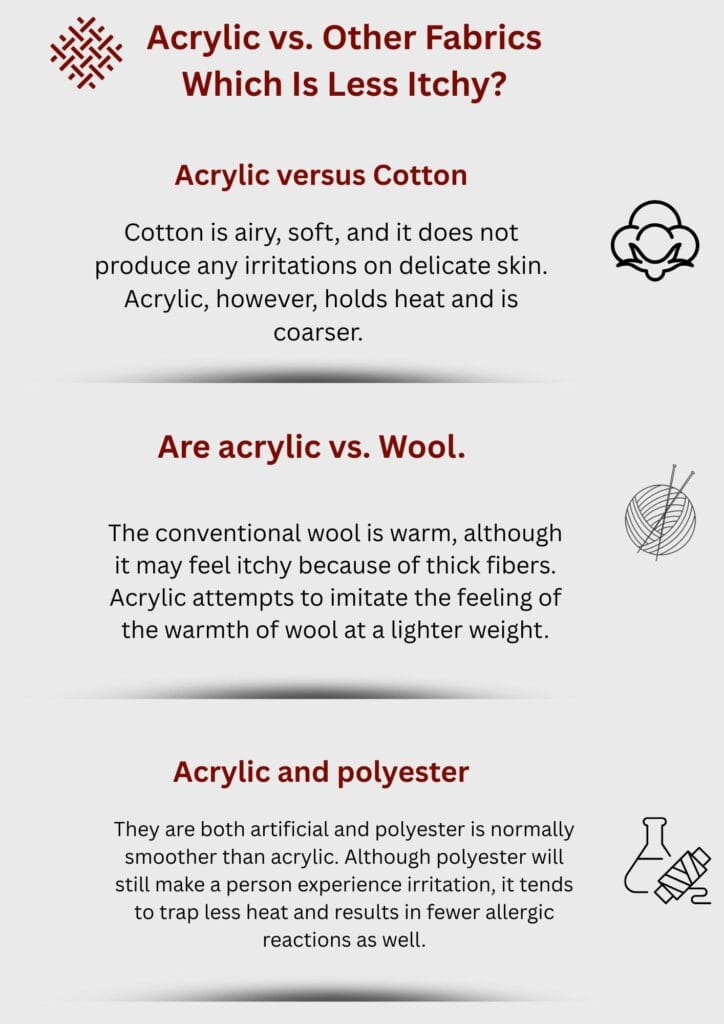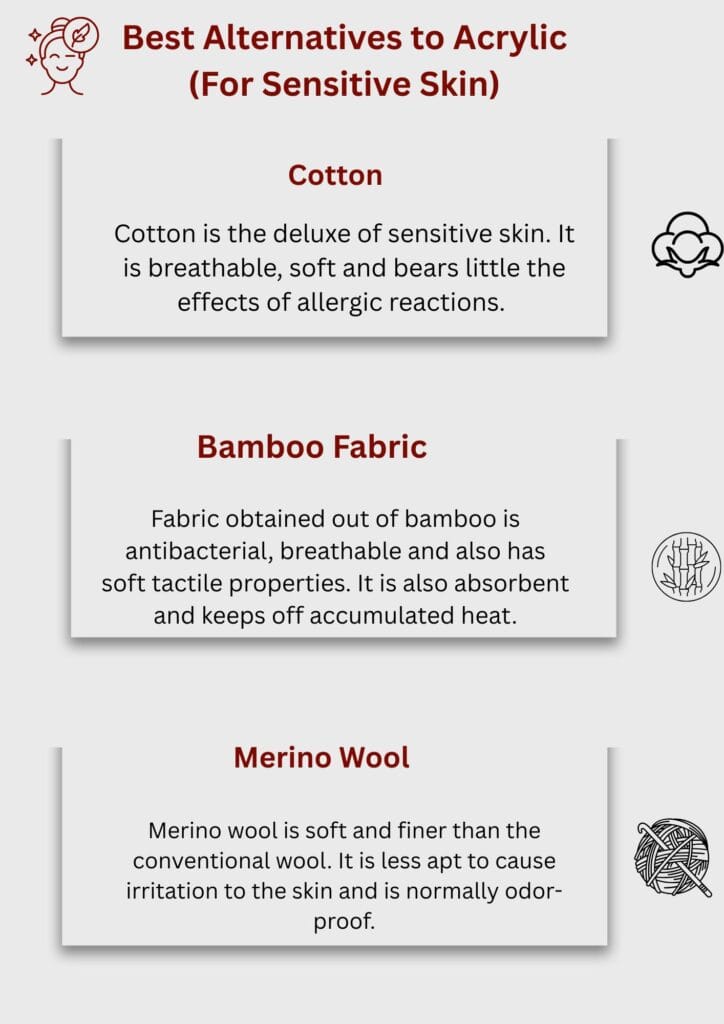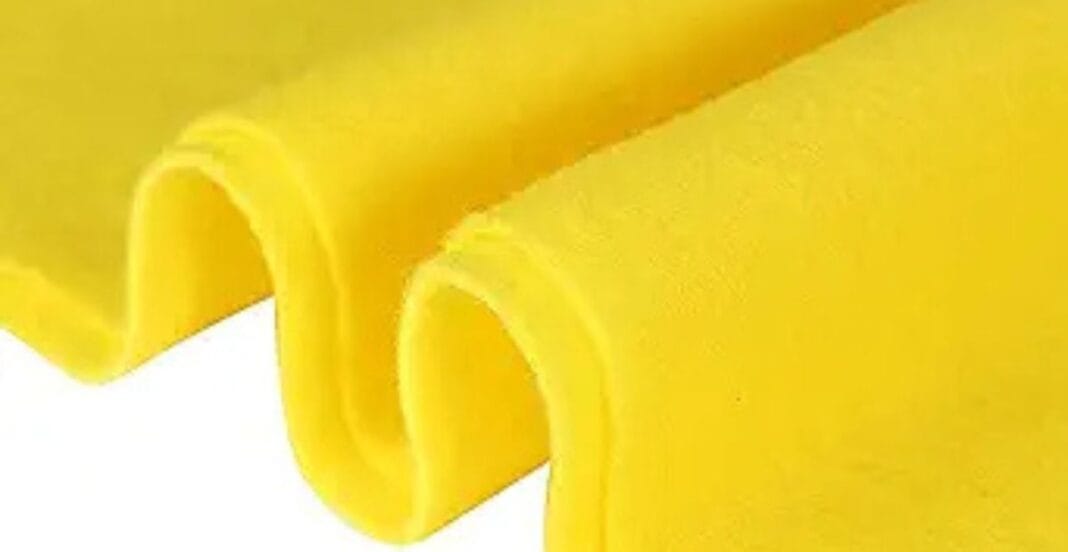Introduction
Acrylic cloth is a common synthetic fiber that is meant to reproduce wool. It is light, warm and cheap and thus, it is versatile to be used as sweaters, scarves, hats and even blankets. But the fact that it is artificially made is of some concern, particularly to individuals with the sensitive skin.
Most people complain of being itchy, irritated and uncomfortable when they wear acrylic attires. All these complaints have prompted one question: Is acrylic fabric itchy, or do they overemphasize such a problem?
Hook: Most individuals actually hate using acrylic clothes but is it really so scratchy as they claim?
In this article, we are going to see science and experience of acrylic fabric and its impact on sensitive skin. We will examine the advantages and disadvantages, suggest how to resolve them and compare acrylic to other popular materials so that you could make the right choice.
Why Is Acrylic Fabric Itchy? (Primary Focus)
When someone says, is acrylic fabric itchy, they would tend to relate such feeling as having prickly or burning. This discomfort is caused by a number of reasons, particularly, in people with sensitive or hyper-reactive skin.
Inability to breathe
Acrylic is non-breathing like cotton or bamboo. Its synthetic fabrics capture heat and water and thereby making it give you that warm and wet atmosphere on your skin. This accumulation of sweat and bacteria may be found irritating, more so, when worn in prolonged periods.
Absence of proper airflow can cause you to have itchy skin, red skin, or swollen skin. This is more rampant in hot temperatures or in exercise. This is one of the reasons why acrylic clothing is not worn by many sensitive people due to the issue of breathability.
Shaggy fiber Structure
Acrylic fibers are rough and somewhat stiff as opposed to the natural fabrics or cotton, cashmere. Such strands are not very soft; they are long-lasting man made strands. Consequently, they are able to shred against the skin and form micro-abrasions.
This friction is easily detected by people with sensitive skins. Although acrylic appears soft on the surface, its microscopic pitting may result to continuous irritation. It leads to itchiness, which would build up in places of friction such as the neck, underarms, or wrists.
Static Electricity
The other problem that is associated with acrylic is that, it produces static electricity. This is so because synthetic fibers lack the ability to absorb moisture. The build-up of the static charges may result in the clinging of the clothing or a light sparking effect on the skin.
Although this feeling is not painful, some individuals may consider it bothering and make them itch. The irritating effect is further aggravated by the fact that the fabric starts rubbing against your body because of the clinginess brought about by static.Is acrylic fabric itchy
Chemical Treatments
Most of the acrylic fabrics undergo dyes, softeners, and preservatives in the manufacturing process. Such chemicals may be present in the fabric until the time the product is bought. In case one has a sensitive skin, allergic reactions could occur when using these residues.
Some of the symptoms can be redness, itchiness, rashes or minor swellings. This is especially concerning to people with an allergy with formaldehyde-based finishes, occasionally added to increase wrinkle resistance to acrylic textiles.
Who Finds Acrylic Itchy? (Target Audience)
The acrylic fabric does not irritate all people. Discomfort is the actual worry of some groups.
Those having Sensitive Skin or Eczema
The synthetic fibers provoke more reactions in people with sensitive skin or such ailments as eczema. The encouragement of their skin barrier is also compromised and therefore is exposed to flare-ups when subjected to irritants such as acrylic.
Acrylic-wrapped clothes may result in dry patches, redness and even eczema outbreak. This renders it very essential that such people select material that is breathable and hypoallergenic.
Persons all Allergic to Synthetic Materials
Certain individuals have allergies toward certain chemicals or compounds in synthetic fabrics. Without the problem of eczema, acrylic might cause them contact dermatitis. In this allergic reaction, itching, burning and redness are common.
Such users will find acrylic not only uncomfortable, but medically unsuitable too. They must not use acrylic and opt to use certified blends that are hypoallergenic.
As compared to Wool
Interestingly, there are individuals that itch more when wearing acrylic as compared to wool but vice versa is also possible. Wool can be coarse, or use a high-quality wool variety such as merino and feel much softer than acrylic. On the other side, lanolin allergic persons (in wool) perhaps can get tempted to use acrylic as a safer alternative.
After all, it is a matter of personal sensitivity and the way the fabric reacts to an individual skin chemistry.
How to Make Acrylic Less Itchy (Solutions)
Good news is that in spite of the fact that acrylic fabric can be itchy, it is possible to make its scratchiness less itchy.
Wash Before we Wear It
Chemical residues of manufacturing can be eliminated by washing new acrylic clothes. These entail dyes, softeners, and preservatives, which can be irritable to your skin. One time laundry using a soft detergent can reduce discomfort so much.
The essence of pre-washing is also to make the fabric cloth soft by getting rid of stiffness. Cold water and non-scorching detergent are best to use.
Fabric Softener or Vinegar Rinse
To smooth the harsh fibers of an acrylic, adding fabric softener during the rinsing cycle can be carried out. To soften up the leftover chemicals, a half-cup of white vinegar may be used to neutralize the chemicals found within.
The two techniques are cost effective and efficient in ensuring that acrylic clothes are less harsh on the skin.
Cotton Wrap
It is also protective to wear a thin cotton undershirt under acrylic sweaters. This little trick stops the cloth to touch your skin directly, decreasing the amount of friction and the irritation.
The benign nature of cotton is breathable and hypo-allergenic, which make it easily layered in synthetic clothing.
Seek Blended Cloths
The acrylic is used together with the weaker natural materials such as cotton, bamboo, or wool in some clothes. These combinations are the best of both words: the money-saving of acrylic and comfortable natural materials.
Be label-wise in buying clothes- preferably 40-60 per cent natural fiber should form the blend to process better within the skin.
Acrylic vs. Other Fabrics Which Is Less Itchy?
The biggest question that can be asked when wearing clothes is whether acrylic fabric is itchy compared to other surfaces.

Acrylic versus Cotton
Cotton is airy, soft, and it does not produce any irritations on delicate skin. Acrylic, however, holds heat and is coarser. Summer wear is more cotton made and to muppets who are itchy.
Cotton comes out a winner in terms of comfort, and hypoallergenic properties in almost every case. Acrylic is however moister resistant and warmer.
Are acrylic vs. Wool.
The conventional wool is warm, although it may feel itchy because of thick fibers. Acrylic attempts to imitate the feeling of the warmth of wool at a lighter weight. However, acrylic is itchier to many individuals as it is a synthetic product with an uneven texture.
But the finest variety of wool, such as merino, is actually smoother and more acceptably tolerated than acrylic.
Acrylic and polyester
They are both artificial and polyester is normally smoother than acrylic. Although polyester will still make a person experience irritation, it tends to trap less heat and results in fewer allergic reactions as well.
Nonetheless, both materials are not exactly recommended by those who have extremely sensitive skin.
Best Alternatives to Acrylic (For Sensitive Skin)
In case acrylic fabric irritates you as it does to some, think about the following softer ones.

Cotton
Cotton is the deluxe of sensitive skin. It is breathable, soft and bears little the effects of allergic reactions. It is also easy to maintain and, moreover, it can be found in numerous styles and weights.
Bamboo Fabric
Fabric obtained out of bamboo is antibacterial, breathable and also has soft tactile properties. It is also absorbent and keeps off accumulated heat. Bamboo is an excellent sustainable choice of those who have skin problems.
Merino Wool
Merino wool is soft and finer than the conventional wool. It is less apt to cause irritation to the skin and is normally odor-proof. Though more expensive, it would be excellent to wear during winter and experience no itch.
Modal/Tencel
Modal and Tencel are semi synthetic fabrics whose elements are natural fibers such as beechwood and eucalyptus. They are smooth, cooling and perfect in summer. The fabrics are luxurious and lack the major disadvantages of acrylic.
Conclusion
Then, is acrylic material harmful to sensitive skin? The short response is: it depends.
Some feel much discomfort of acrylic garments, whereas others can wear them without any problem. Major roles are played by factors such as the type of skin, the structure of the garment and the chemical treatment. The upside is that there is a way to alleviate the itch with measures such as washing, layering and mixing of fabrics.
To those with sensitive skins, use a small piece of acrylic first and then purchase additional ones when you have been satisfied. Even better, choose such options as cotton, bamboo, or merino wool to stay comfortable in the long run.


